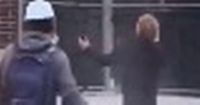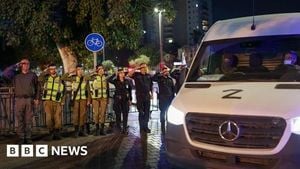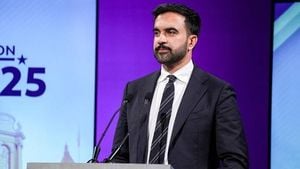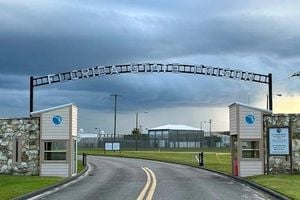On a September evening in 2025, outside the Immigration and Customs Enforcement (ICE) detention center in Broadview, Illinois, a scene unfolded that would ignite national debate and legal action. Reverend David Black, a Presbyterian minister and senior pastor at the First Presbyterian Church of Chicago, stood among protesters, dressed in black and wearing his clerical collar, as he prayed and called out to ICE agents stationed on the roof above. What happened next, captured in a now-viral video, has since become a flashpoint in the ongoing struggle over immigration enforcement and civil liberties in the United States.
The footage, first recorded by activist Kelly Hayes and circulated widely on social media in early October, shows three ICE agents on the roof of the facility. Suddenly, without apparent warning, one agent fires a pepper ball projectile at Black, striking him on the top of his head. The pepper ball explodes in a puff of white powder, and Black collapses to his knees, coughing and clutching his head. Protesters rush to his aid, while, according to several witnesses, the agents continue firing pepper balls into the crowd. "We could hear them laughing," Black later recounted to Religion News Service, still struggling with respiratory issues weeks after the incident.
This event did not happen in isolation. According to Truthout and The Independent, the Broadview ICE facility had become a focal point for demonstrations against the Trump administration’s aggressive immigration policies. The protests drew faith leaders from across Chicago, including Christian, Jewish, and Muslim clergy, many of whom had previously been arrested during similar actions. The night Black was shot, hundreds of ICE agents had descended on the city, conducting a series of raids that, according to witnesses, included detaining and zip-tying children in a South Shore apartment building.
The incident with Black quickly drew condemnation from activists, politicians, and religious leaders nationwide. The American Civil Liberties Union (ACLU) announced on October 6, 2025, that Black was among several plaintiffs petitioning a federal court for an emergency order to halt what they described as the government’s "illegal and brutal suppression of First Amendment rights." The lawsuit, filed in early October, accuses the Trump administration of violating demonstrators’ and journalists’ constitutional rights, as well as the Religious Freedom Restoration Act, by using excessive force to silence protest and religious expression.
According to the complaint, ICE agents at the Broadview facility and elsewhere in Chicago had "indiscriminately" used chemical irritants, flash grenades, and rubber bullets against demonstrators. The lawsuit details how officers in "full combat gear" targeted not just protesters but also clergy and reporters, sometimes arresting them and detaining them incommunicado for hours. "No legitimate purpose exists for this brutality or for these arrests," the plaintiffs’ lawyers wrote. "The officers are not physically threatened. No government property is threatened. Defendants are acting to intimidate and silence the press and civilians engaged in protected First Amendment activities."
Black’s own account underscores the religious dimensions of the protest. "I invited them to repentance," he told Religion News Service. "I basically offered an altar call. I invited them to come and receive that salvation, and be part of the kingdom that is coming." The lawsuit further alleges that the government’s actions "substantially burdened" Black’s and other clergy members’ exercise of religion, in violation of federal law. The complaint also cites the case of Rev. Beth Johnson, a Unitarian minister who was "fired upon without warning or justification as she and other protesters and clergy members stood on the sidewalk singing ‘We Shall Overcome’ and other traditional songs of protest." Similarly, Rev. Hannah Kardon, a United Methodist pastor, reported being targeted with pepper balls while praying with her eyes closed and hands lifted.
Faith leaders across the United States, including prominent Catholic figures and even Pope Leo XIV, have spoken out against the Trump administration’s mass deportation campaign and the use of force against peaceful religious protest. "We’re a faith of immigrants — Jesus was an immigrant," Rev. Kardon told Religion News Service. "But to me, this is basic created-being stuff. When you see what is happening here, your whole body and heart resists it because it’s fundamentally wrong."
The Trump administration has defended its actions, with lawyers arguing that the plaintiffs are attempting to "dictate crowd-control policy in ways that would tie the hands of federal law enforcement officers… even in circumstances of imminent danger." According to government lawyers, more than 30 ICE agents have been injured during the protests, including multiple hospitalizations, and over 50 people have been arrested. They maintain that the constraints sought by the plaintiffs are "untenable on their face."
The issue has also become a political flashpoint. On October 8, 2025, President Donald Trump escalated tensions by publicly calling for Chicago Mayor Brandon Johnson and Illinois Governor JB Pritzker to be jailed over their criticism of the ICE raids. Meanwhile, critics of the administration, such as Zeteo editor-in-chief Mehdi Hasan, have called for the abolition of ICE, describing the agency’s recent actions as "rogue" and "fascist." The Department of Homeland Security (DHS), for its part, has continued to justify the raids and the use of force, claiming that hundreds of undocumented immigrants have been arrested in recent weeks. However, the Trump administration has previously been accused of inflating arrest numbers to satisfy political demands, according to Truthout.
For Black and the other plaintiffs, the legal battle is about more than just their own injuries. The lawsuit seeks to set a precedent protecting the rights of demonstrators, journalists, and faith leaders to protest and bear witness without fear of violence or retaliation. As the ACLU stated, the case is an urgent response to "the government’s illegal and brutal suppression of First Amendment rights." Storyful, which first published the footage, noted that Black was helped by people at the scene and is recovering, but the long-term effects — both physical and societal — remain uncertain.
As the courts prepare to weigh in on the case, the events in Broadview have already left an indelible mark on the national conversation about civil liberties, religious freedom, and the limits of governmental power. The debate over how to balance public order and individual rights continues, but for those who stood outside the ICE facility that night, the stakes are anything but abstract.




